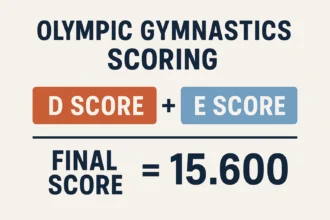To the casual observer, ballet and gymnastics may look like two entirely different worlds. Ballet feels soft, elegant, and expressive, built around music and storytelling. Gymnastics appears powerful and explosive, filled with flips, twists, and daring acrobatics.
But behind these surface differences, the two disciplines share a surprising number of similarities.
How Ballet and Gymnastics Complement Each Other
1. Shared Foundations: Control, Alignment, and Awareness
Both ballet and gymnastics require athletes to master their bodies in three dimensions. They must control posture, shape, timing, and movement quality with precision.
Ballet builds:
- elongated posture
- turnout awareness
- strong core and hip stability
- refined arm, foot, and head placement
- awareness of lines and body shapes
Gymnastics builds:
- dynamic power
- spatial awareness
- rapid muscle engagement
- ability to control movement during jumps, flights, and landings
- tight, efficient body shapes needed for flips and rotations
Together, they form a complete movement foundation. Ballet teaches gymnasts to move with intention and refinement; gymnastics teaches dancers to move with confidence and athleticism.
2. Artistry and Presentation: Ballet’s Gift to Gymnastics
While gymnastics is heavily skill-based, presentation matters especially on floor and beam. Judges look for:
- fluid transitions
- expressive movement
- clean lines
- musicality
- confident performance
Ballet training strengthens all of these. It teaches athletes:
- how to use their arms and upper body gracefully
- how to connect dance steps smoothly
- how to point their toes and extend their legs fully
- how to move with rhythm and intention
- how to perform, not just execute skills
A gymnast with ballet experience often “looks different”. Their movements appear cleaner, their leaps more extended, and their choreography more natural and confident.
3. Strength and Power: Gymnastics’ Gift to Ballet
Gymnastics, on the other hand, brings qualities ballet dancers don’t always train as heavily:
- explosive jump strength
- powerful takeoffs
- precise, stable landings
- strong upper-body conditioning
- confidence during aerial movements
- quick reaction ability
These skills can elevate a dancer’s performance, especially in contemporary, acro-dance, and advanced jumping sequences. Many dancers find that the strength gained from gymnastics makes them feel more secure, balanced, and capable in their choreography.
4. Injury Prevention Through Balanced Training
Gymnastics is repetitive and high-impact: tumbling, vaulting, and dismounts place heavy demands on the joints. Ballet offers a different angle of training:
- slower, controlled movements
- lower impact on ankles and knees
- emphasis on turnout and alignment
- development of small stabilizer muscles
This balance can reduce overuse injuries and improve joint health. Meanwhile, the strength from gymnastics helps dancers stabilize their ankles, land more safely, and develop resilient muscles.
Together, the two disciplines produce a more well-rounded, injury-resistant athlete.
Where Ballet and Gymnastics Contrast Each Other
Although they complement each other well, ballet and gymnastics are fundamentally different. These contrasts matter and help explain why some skills translate well while others do not.
1. Technique Differences: Turnout vs. Parallel
Ballet relies heavily on turnout (external rotation from the hips). Almost every movement like plié, tendu, pirouette begins with turnout.
Gymnastics, however, uses mostly parallel leg alignment:
- straight run for vault
- parallel hips during tumbling
- internally rotated shapes for twisting
- parallel landings for safety
If athletes confuse these techniques, it can lead to improper mechanics or increased injury risk. The key is learning when to use turnout and when not to.
2. Aesthetic Illusion vs. Athletic Power
Ballet aims to:
- create long, uninterrupted lines
- move as though floating
- make effort invisible
- connect movement continuously
Gymnastics aims to:
- explode into tumbling passes
- create high amplitude
- show visible power
- land solidly and safely
Both are beautiful, but they prioritize different types of movement and expression.
3. Rhythm and Timing Differences
Ballet is deeply musical. Dancers follow phrasing, tempo, counts, and dynamics. Movement grows from the music itself.
Gymnastics is partially musical (on floor) but also structured around:
- momentum
- speed
- timing for takeoff and landing
- transitions between skills
On beam, the rhythm is controlled but not musical. On bars, tempo is dictated by swing speed. On vault, rhythm is pure sprint mechanics.
This creates a contrast in how athletes think about timing and movement quality.
4. Training Structure and Body Development
Ballet training:
- emphasizes gradual progression
- strengthens stabilizers and flexibility
- develops long muscles and refined control
- often includes 5–10 years of slow mastery
Gymnastics training:
- builds explosive power quickly
- develops fast-twitch muscles
- introduces complex skills at younger ages
- prioritizes strength, speed, and coordination
Because of this, athletes often gravitate more naturally toward one discipline based on personality and physical tendencies.
5. Differences in Scoring and Evaluation
Gymnastics has a formal scoring system based on:
- difficulty
- execution
- artistry
- deductions
Every movement is judged numerically.
Ballet does not use a scoring code. Whether in class or performance, ballet is judged more holistically on emotion, expression, line, musical interpretation, and visual cohesion. This difference shapes how students approach performance in each discipline.
How to Combine Ballet and Gymnastics Effectively
For many athletes, combining ballet and gymnastics is incredibly beneficial. But the approach must be thoughtful.
Start Ballet Early for Gymnasts
Ages 5–10 are ideal for introducing ballet to gymnasts. It builds:
- posture
- core strength
- toe point
- balance
- rhythm
- movement awareness
This foundation supports gymnastics skills later on.
Keep Ballet Training Modular and Manageable
Instead of full dual training, most gymnasts benefit from:
- 1–2 hours per week of ballet
- focused sessions on turnout, arms, and extension
- cross-training rather than formal ballet track
This prevents burnout while improving artistry.
Know Which Gymnastics Events Benefit Most from Ballet
- Beam: posture, quiet landings, lines, balance
- Floor: leaps, dance skills, transitions, choreography
- General form: toe point, arms, carriage
Vault, bars, and tumbling use mostly power mechanics, so the transfer is less direct.
Summary Table
| Feature | Ballet’s Strength | Gymnastics’ Strength | Key Difference |
|---|---|---|---|
| Movement quality | Long lines, turnout, grace | Tight shapes, power, amplitude | Aesthetic vs athletic emphasis |
| Strength | Stabilizers, control | Explosive, dynamic power | Slow control vs fast force |
| Flexibility | Gradual, aligned | Dynamic and functional | Turnout vs parallel |
| Performance | Musicality, expression | Precision, difficulty scoring | Artistic storytelling vs athletic scoring |
| Training | Steady refinement | Skill progression, speed, strength | Long-term artistry vs early intensity |
In summary, ballet creates grace, musicality, and discipline. Gymnastics builds courage, athleticism, and explosive capability. Together, they produce athletes who are more expressive, more controlled, and more versatile.












